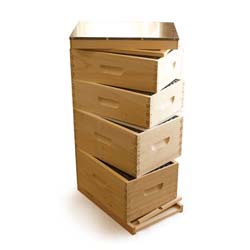When beekeepers first start learning about overwintering, the advice can feel all over the place. Some sources say, “Wrap your hives in insulation.” Others insist, “Ventilation is everything—never wrap!” One expert swears by sugar cakes starting in October, while another says not to feed until February.
It’s easy to feel confused. The truth is, all of those approaches can be right—just not all right for the same place. As one experienced mentor put it, “They’re all right. They’re just not all right for here.”
Winter challenges vary dramatically depending on where bees are kept. Understanding what makes winter difficult in a specific location helps beekeepers make smarter preparation decisions—and prevents applying advice meant for someone else’s climate.
The Three Big Variables
When it comes to what makes winter challenging for bees, three main factors matter most: how long winter lasts, how cold it gets, and how moisture patterns affect the hives.
Winter length might seem straightforward, but it’s about more than just calendar dates. Some regions experience four months of cold weather; others face seven or eight. The difference matters because bees need enough stored honey to fuel their cluster for the entire period. A hive in a four-month winter might need around 60 pounds of honey, while one in a seven-month winter could require 90 pounds or more.
Temperature extremes determine how tightly bees need to cluster and how much energy they burn to stay warm. In milder winters, where temperatures rarely drop below 20°F, clusters stay looser and bees can move to new food stores more easily. In areas that reach -20°F or colder, the cluster must contract tightly just to survive. Tighter clustering means less mobility—and sometimes bees starve with honey just inches away because they can’t break cluster to reach it.
Moisture patterns are the silent challenge many beekeepers overlook. Some regions have dry, crisp winters where moisture management is simple. Others—especially coastal or snowy regions—deal with constant humidity. That moisture turns warm air from the cluster into condensation on cold hive surfaces. When it drips onto the bees, it can chill and kill them. In these climates, ventilation becomes absolutely critical.
Other Challenges Worth Knowing
Some regions experience unexpected warm breaks in mid-winter. A week of 60-degree weather in January may sound pleasant, but it can confuse the colony. Bees break cluster, fly, and consume stores—only to be hit with another hard freeze. These temperature swings can be more stressful than consistent cold.
Wind exposure also plays a role. Constant winter winds pull heat away from the hive faster than still air. Hives on open hillsides or in fields face different challenges than those sheltered by trees, buildings, or windbreaks.
Why Your Location Matters
Here’s what this means practically: your winter preparation needs to match your specific climate challenges. A beekeeper in coastal Maine preparing for long, damp winters will make different decisions than someone in inland Montana facing extreme cold but dry air. Neither approach is “wrong”—they’re adapted to different conditions.
The best resource for understanding your specific challenges? Your local beekeeping club. Local beekeepers have already learned, through experience, what winter throws at colonies in your region. They know when to add moisture quilts versus when extra ventilation matters more. They understand your typical honey storage needs and local wind patterns.
Winter is harder in some places than others—but bees have been adapting to diverse climates for thousands of years. Your job isn’t to master every possible winter scenario. It’s to understand your winter, prepare thoughtfully for it, and trust your bees’ remarkable ability to handle the cold.
